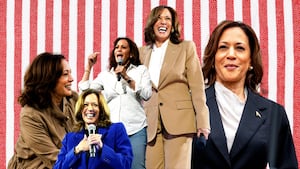In experience and qualifications, Kamala Harris is more than ready to become the first female president of the United States. But amid the biggest political battle of her life, Harris has failed to leverage one of the most powerful communication tools for female leaders: her sense of style. There’s no underlying strategy—a fashion scaffolding, so to speak—that undergirds her clothing choices and unifies them with her core values and political messaging to reach her target audiences.
Case in point: In contrast to Harris’ attire, her running mate, Tim Walz, has been lauded for his pointedly all-American, everyman attire—those wildly popular Harris/Walz camo baseball caps, for example. Citing his love for outdoors outfitter L.L. Bean and construction gear company Carhartt, among other folks brands, Guardian editor Betsy Reed recently asked, “Can Tim Walz’s wardrobe win the White House?”
For much of her career as a prosecutor, senator, vice president, and now presidential candidate, Harris has been pragmatic and risk-averse in her sartorial choices, filling her wardrobe with the requisite staid pantsuits and dated “pussy bow” blouses. Maybe in part because of the time spent in musty courtrooms?
Broadly speaking, these pantsuits are often poorly tailored; in color and style, they don’t do justice to her flawless skin, delicate face, and petite figure. (Furthermore, her jackets are too long and almost always buttoned at the waist—the most unflattering place a button can be for most women.) “Pantsuits do give an impression of power and authority,” says Catherine Jackson, founder of image consulting firm PowerStyle and creator of the popular Instagram channel @thepowerstylist. “But I find it a bit difficult to see her shape because of the suits that she wears… I feel that they swamp her slightly.”
Yes, these fashion failings are generational—a product of workplaces and professional cultures that did not center (or even allow) femininity—or women. But as a South Indian immigrant of Harris’s generation, I viscerally recognize the boxy padded pieces that the vice president has long embraced. To us immigrants in the ’80s, the pantsuit was one of the first symbols of assimilation into the American workforce. The subtext: “I can be like you. I am like you.”
In some ways, Harris’ attire feels like she is still fighting that age-old fight for assimilation, though she is of course an American-born citizen herself. What she needs to do is to acknowledge—even more, to thrive in the knowledge—that in some ways, she’ll always be the outsider. Immigrants and other minorities almost always are.
For us immigrants—first and second generation—these social constraints are constantly in flux. As times change, so does the way we assimilate and observe the aesthetic practices of our new home countries; the American Dream is not a dream of days gone by, after all. Harris could—and should—proudly represent America’s modern-day diaspora through subtle nods to her roots in her wardrobe.
She has a rich cultural heritage—from India and Jamaica—she could tap into: gorgeous fabrics in vibrant colors, for example, or intricate jewelry. Jackson believes Harris’ preponderance of subdued suits in navy and other blues, while signaling trust and dependability, reads as uninspiring writ large. Instead, Harris would benefit from clothes and accessories with hints of green (to represent growth) or energizing jewel tones, like ruby red and shades of purple.
Fashion brands today are revolutionizing women’s pantsuits for the modern-day executive with a focus on feminine tailoring (narrower pants cut to the ankle, for example), vibrant colors, textures, and accents. To break the ultimate gender barrier, Harris has to embrace these new norms to signal modernity, effortless confidence, and a willingness to be different—a sartorial symbol of the melting pot-born generation of Americans that she embodies.
Chitra Ragavan is an executive leadership coach and strategic adviser to CEOs and thought leaders. She has served as a national correspondent for NPR and U.S. News & World Report, and contributes thought leadership to The Hill, Psychology Today, and the women’s digital platform SWAAY. She hosts the podcast When It Mattered, exploring pivotal moments that shape leaders’ lives and work.








